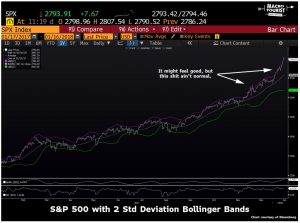
Source: pixabay
If one is to believe what he or she reads in the financial press, then one thing seems certain: the markets are about to melt! The problem is, that depending on the day, the source, and perhaps even the lunar cycle, it’s not clear whether the markets are about to melt up or melt down.
It goes without saying that this seemingly simple question of (melt) up or down is a crucial one, and the directional uncertainty can be paralyzing. With stakes so potentially high, what’s an investor to do? Step to the sidelines and wait it out? Place a bet and hope for the best? Consult a guru?
How about developing an investment framework capable of handling extreme environments?
“Develop an investment framework? Who needs one of those”? Or, ”I’ve already got one that works really well for me”, you might be saying to yourself. Hear me out.
We investors have a tendency to view the world through the lens of dichotomies. Is an equity a growth stock or a value stock? Were my returns generated from alpha or beta, or from fundamental or technical reasons? Will markets melt up or melt down?! There’s a lot of utility to this type of approach. In fact, I very much would like to keep it, but rather change the poles on the spectrum to those of value and momentum.
Before getting into the details and merits of employing a value-momentum framework (VM for short) let me first give credit where credit is due. I by no means invented this approach; I stumbled across it via a podcast interview with Dr. Wesley Gray of Alpha Architects, a quantitative investment management firm. Plenty have thoroughly researched the topic (see here and here for some notable examples), though it has remained largely relegated to the world of “quants.” I’d like to liberate it for the rest of us.
Value should be a familiar concept to anyone. It simply means getting something on the cheap. Value investing is most commonly applied to equities, and typically entails buying securities below intrinsic value (however one wants to define that term). The strategy requires investing in companies that have been “left for dead”, in the anticipation that a reversal of fortunes is in order. By buying “cheap” stocks of “good” companies, the value investor is wagering that, at some point, strong (enough) fundamental performance will (re)attract capital to those companies. This should cause valuations to mean-revert upwards and produce outsized profits in the process. Value investing is also a risk adverse strategy meant to limit one’s downside, the theory being that prices can only fall so far (so long as you’ve selected a decent company), as the marginal sellers have largely move on. While I’ve described value investing in terms of equities, these principles can be applied universally to any asset class with some minor tweaking.
Momentum describes the phenomenon where “winners” keep winning and “losers” keep losing. In other words, things continue on as they are; that current trends (more or less) persist into the future, with the outperforming investments outperforming and the underperforming ones lagging. It arguably is what has underpinned the outperformance of the FANG stocks, the Nifty Fifty in their day, and perhaps even negative yielding sovereign bonds. Momentum is also the implicit strategy of passive investing instruments (as constituents that appreciate become a greater part of the index, causing the strategy to buy more of it in a self-reflexive manner).
Note the difference between these two approaches. In simple terms, momentum is a trend following strategy while value banks on trend reversals. They are near opposites with respect to capturing price movements. Thus, melt up: overweight momentum positions; melt down: go with value ones. (My preference is to frame this in convexity terms whereby momentum is short convexity and the value is long, though such a discussion is beyond the scope of this article.)
Historically speaking, investing at high valuations have led to poor future returns (see some of Dr. John Hussman’s work here on equities; low bond yields and high durations speak for themselves), however, valuations have never been a good timing tool. Investments can always get more expensive and ignoring this fact can cause one to miss out on some material returns and, for professionals, create some serious career risk.
As I discussed in my previous blog post, there appears to be a healthy dose of financial asset inflation present in investment valuations. By some measures (highlighted in these two recent blog posts, one by Jesse Felder and one by Kevin Muir), we’re sitting at historical outliers. This is not a conducive environment for the value investor. In fact, momentum has ruled the day, and those patiently positioning for a change in trend have significantly underperformed. An illustration of this is that the iShares Momentum EFT (ticker: MTUM) has outperformed its value brethren (ticker: VLUE) and the S&P 500 by ~37% and ~29%, respectively (from 4/18/13 until 2/2/18).

What’s a value investor to do in such an environment? What would a momentum investor do if the environment suddenly changed to a choppy one without reestablishing a clear direction (one in which momentum would be expected to lag)? Should one sit it out, stubbornly sticking with his/her process and underperform (noble, but potentially career ending); rationalize some form of FOMO investing strategy (never a good idea), or; adapt? The best do the latter of course.
Jack Schwager, in his infamous Market Wizards book, illustrates the epitome of adaptive investing with his interview of legendary investor Paul Tutor Jones (PTJ). PTJ recounts a time for the reader where he not only exited a losing position early (what some would consider trading risk management 101), but reversed it completely, turning a long position in cotton futures into a short one. That nuance of not just selling his futures stake, but going the extra step to short it, is what made PTJ so successful.
Clearly not all of us are as gifted as PTJ, nor do we have the same investing style (the PTJ interview chapter is entitled “The Art of Aggressive Trading”). However, a lack of instinct need not be an impediment to investing success. This is where the VM framework comes in.
Classifying individual positions and asset class holdings along a spectrum of value and momentum could give us insight into the characteristics of our portfolios and how they might perform under certain circumstances. While quantitative data is helpful, it need not be necessary (why should the “quants” have all the fun?). Just think, why do you hold each position? Is it cheap on its own, or for exposure to certain markets or events? What would make you sell it? Then, ascribe a label of value or momentum, or better yet, make up your own scale (like Value-Weak, Momentum-Strong, etc.). Next, think about what you’d do if you knew with certainty that markets were about to either “go parabolic” or fall off a cliff. What would you buy? What would you sell? What would you short? This simple exercise may give you a glimpse into how your portfolio might perform (and how you might react) in either a melt-up or meltdown scenario, and hopefully provide you with some optional strategies to employ.
The indecision created by seemingly extreme market points such as today’s can be paralyzing. Of course we can’t know with certainty how the future will play out, but creating tools such as the VM framework can help us overcome our emotions and invest outside of our comfort zone. This way, no matter which way the market melts, we’ll have a tool handy to potentially catch some of the drippings and profit without the anxiety that comes with compromising our investing standards.
As always, please feel free to leave comments and start a discussion. We love to hear your feedback and hope to create a dialogue around the topics of our articles.
